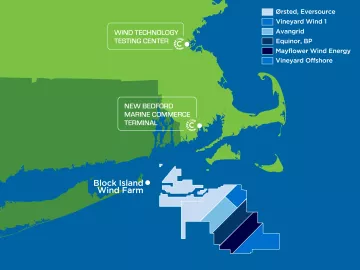Why Wind?

Wind power is a key part of transitioning off of polluting, risky energy sources like fracked gas, and to building a robust renewable energy economy. This is especially relevant to Massachusetts, where U.S. Senator Ed Markey dubbed the areas off of our southern coast the “Saudi Arabia of wind” due to the consistent wind patterns that will allow utility-scale offshore wind farms to produce incredible amounts of clean, safe energy. To meet the goals in the Roadmap, the commonwealth must contract 5,600 megawatts of offshore wind by 2027. In early 2024, Vineyard Wind delivered the first locally sourced wind power to Massachusetts, delivering enough electricity to power 30,000 homes with future capacity to power more than 400,000 homes and businesses.
Offshore wind is a massive economic opportunity for Massachusetts. The cities of Salem and New Bedford, Massachusetts are poised to lead the nation in assembly and deployment of offshore wind equipment. Not only will the Commonwealth’s embrace of offshore wind bring local investment, much like solar it will also bring thousands of local family-sustaining jobs, cleaner air, cleaner water, healthier people, and a safer climate.
We have an astounding amount of offshore wind potential:
- According to the National Renewable Energy Laboratory (NREL) the Atlantic Ocean has 1,283.5 gigawatts (GW) of potential offshore wind on the Eastern seaboard. That’s enough to power most of the homes along the Atlantic coast.
- According to Environment Massachusetts, our state’s offshore wind potential is equivalent to 19 times our state’s annual electricity consumption.
- Even with all of our transportation and heating systems converted to electricity, offshore wind could still produce 8 times Massachusetts’ annual consumption.
Despite these clear benefits, your voice is still needed to help accelerate Massachusetts progress
Support Offshore Wind in MA
Everyone can help support Offshore Wind in Massachusetts! Leverage the below resources to learn more about the issue, submit a public comment, engage your municipal leaders, and show up in person to demonstrate your support of wind!
Learn:
- Access our Offshore Wind Information Sheet Here: Offshore Wind Fact Sheet
- Review our Offshore Wind 1-Pager
- Watch our webinars on wind here:
- Read our report, prepared by Synapse Energy Economics: Charting the Wind: Quantifying the Ratepayer, Climate, and Public Health Benefits of Offshore Wind in New England
Take Action:
- Engage your municipal officials in supporting offshore wind: Toolkit: Contact your municipal official to support Offshore Wind in Barnstable!
- Support offshore wind with public comment: Public Comment Toolkit
To learn how you can get involved, contact Sam Lambert.
Resources
WOMR “Cape Climate” radio show, "Offshore Wind - Don't Be Fooled!”
Real Offshore Wind: Answers You Can Trust
Against the Wind: A Map of the Anti-Offshore Wind Network in the Eastern United States
Union Members See the #OffshoreOpportunity at the Block Island Wind Farm